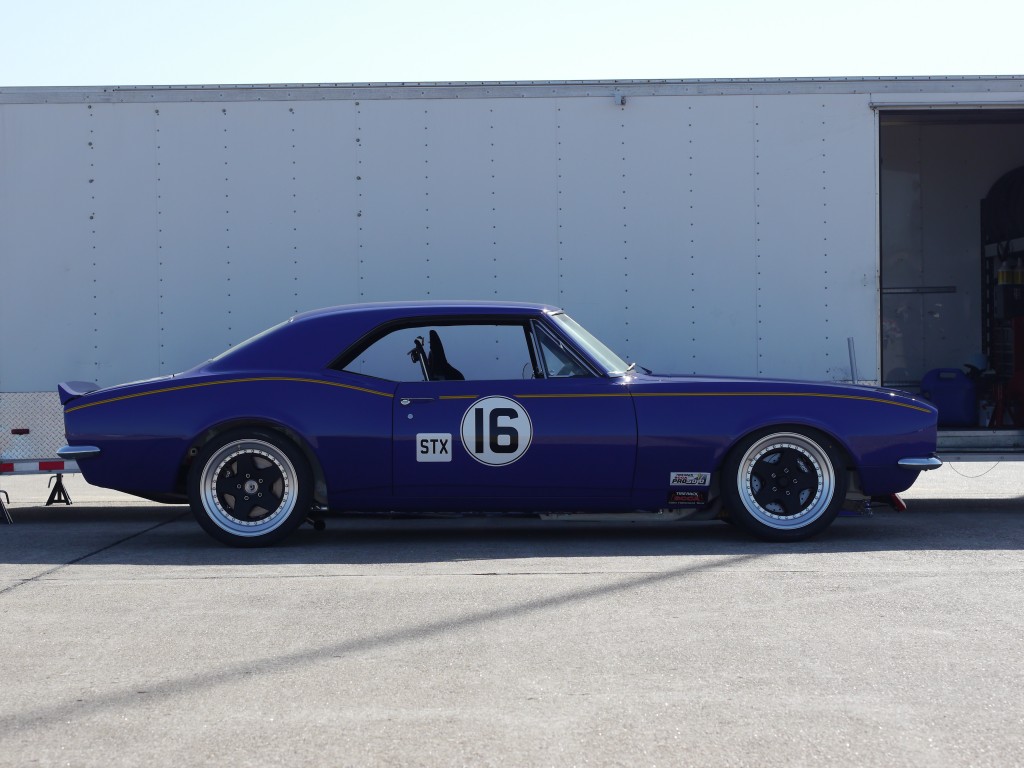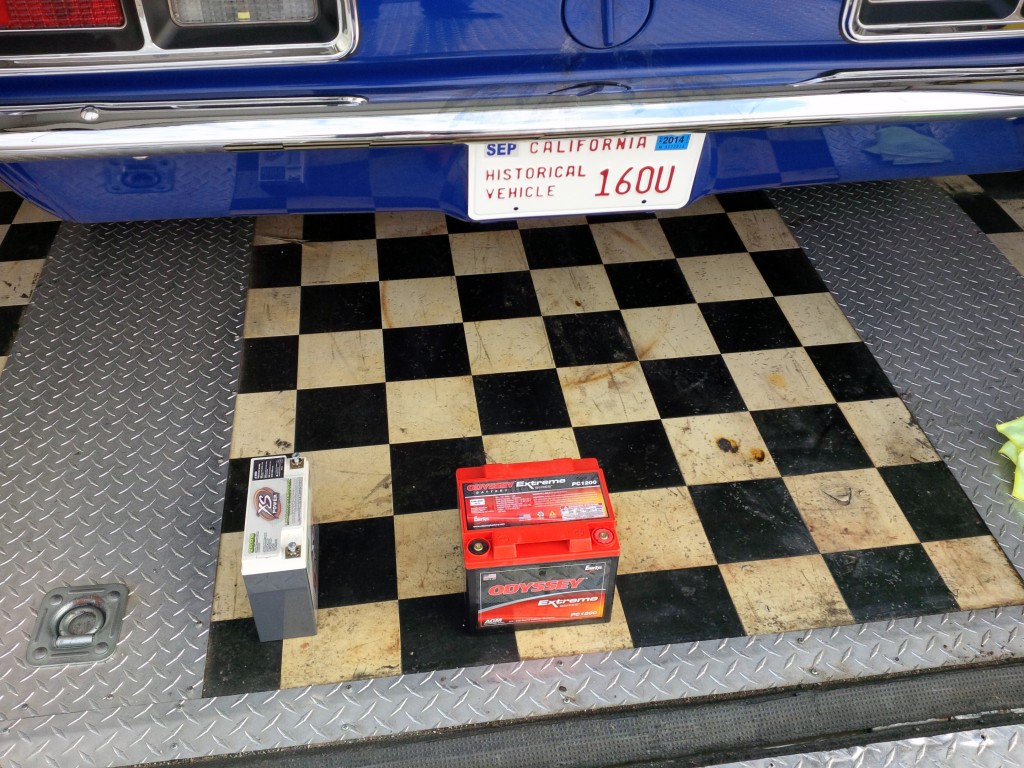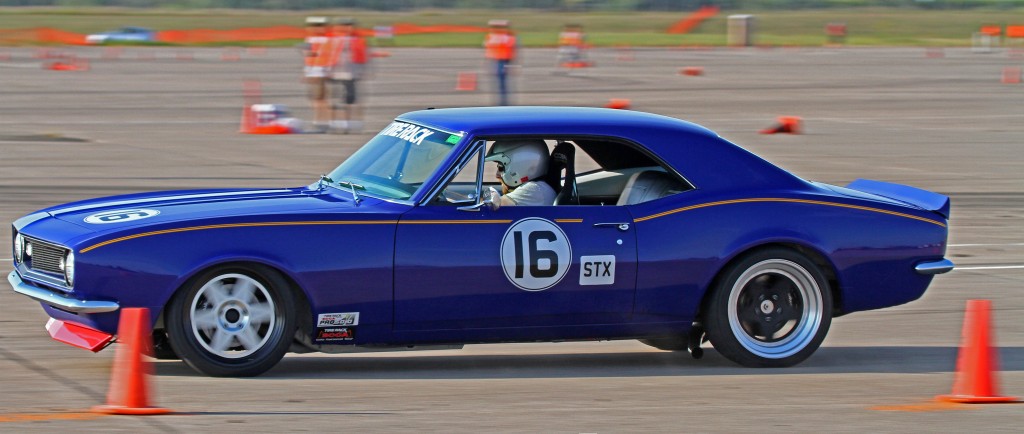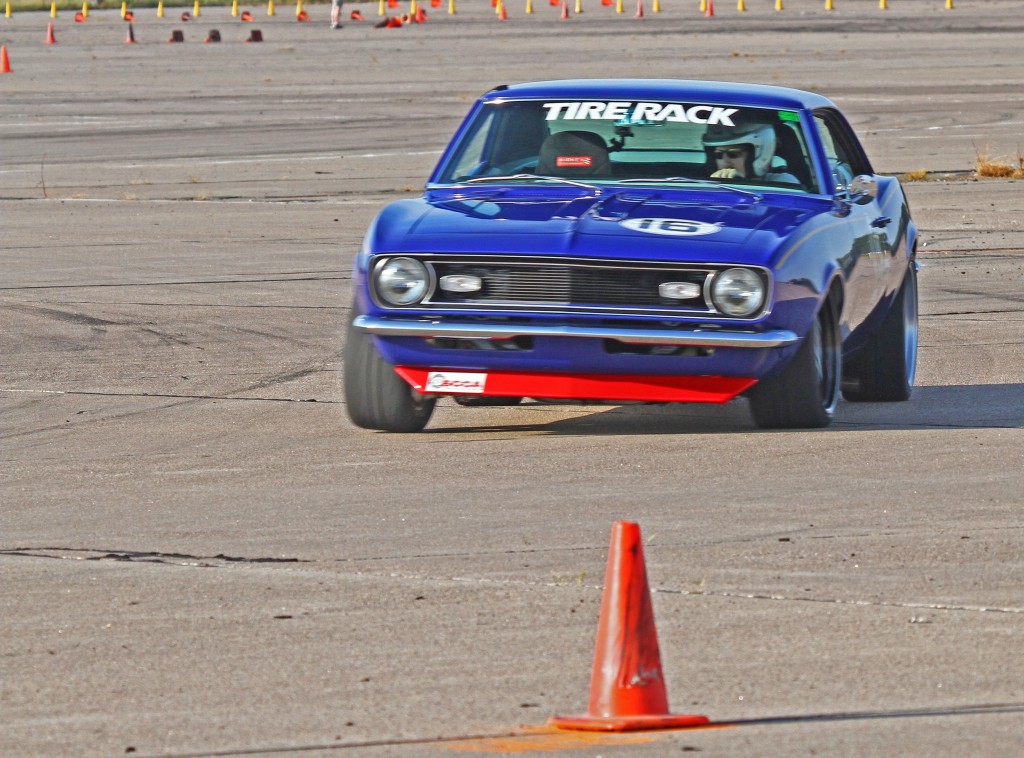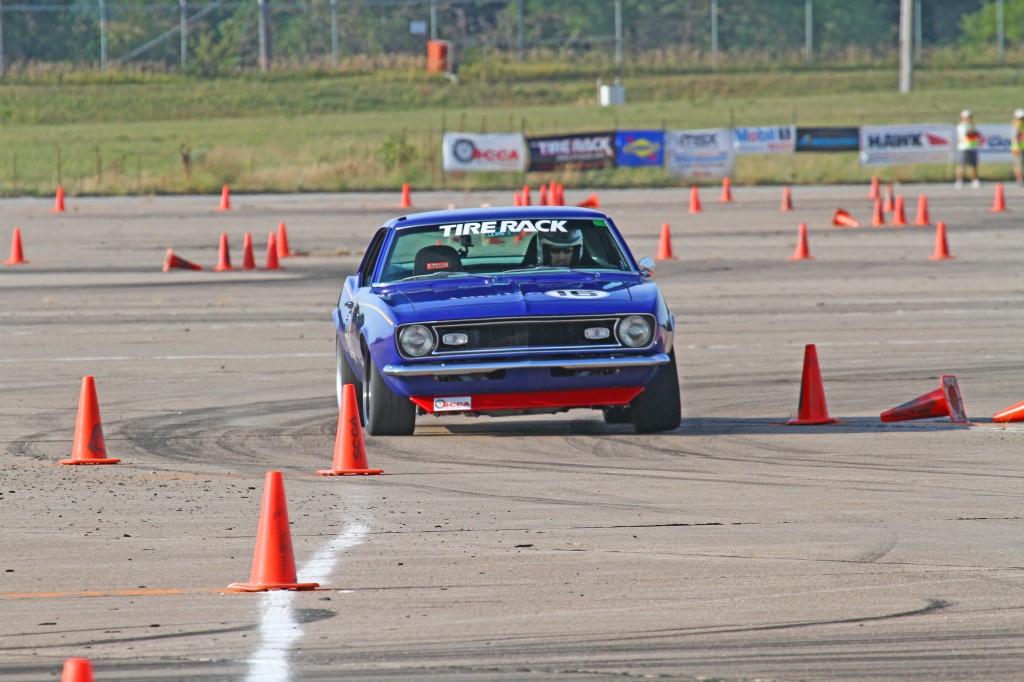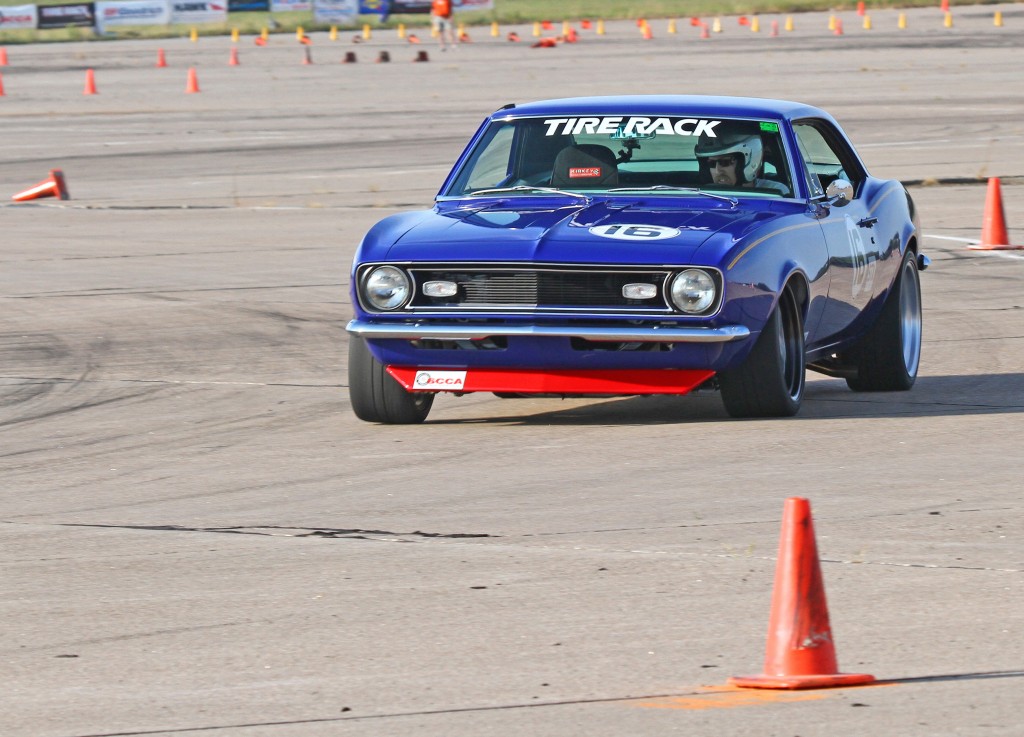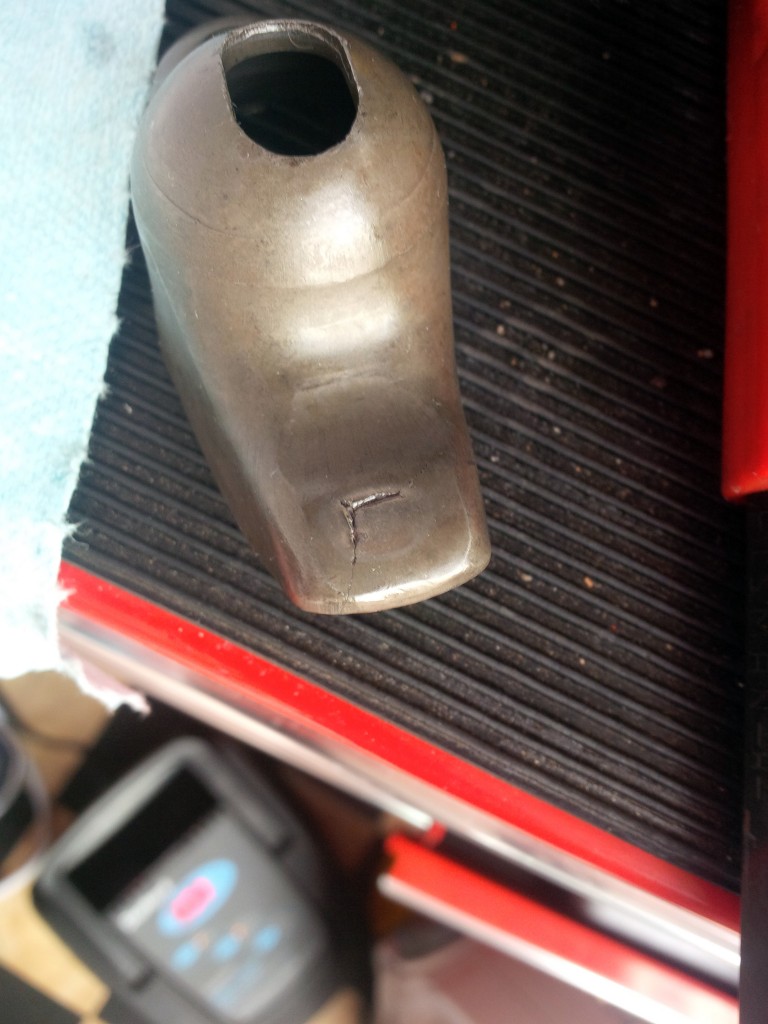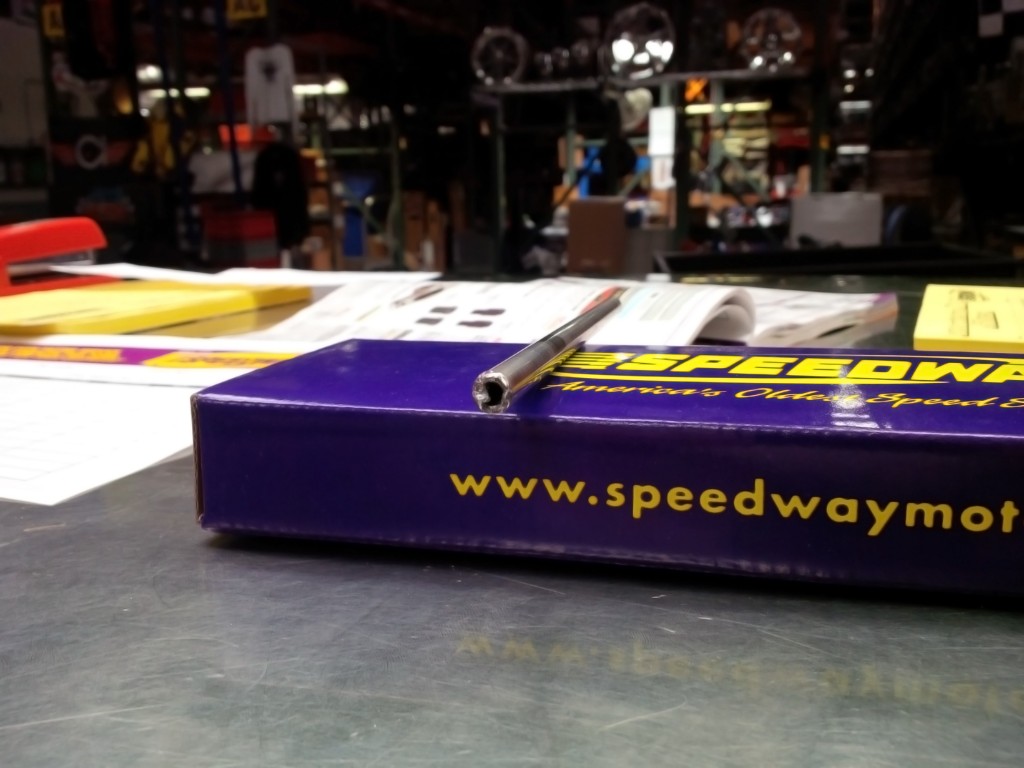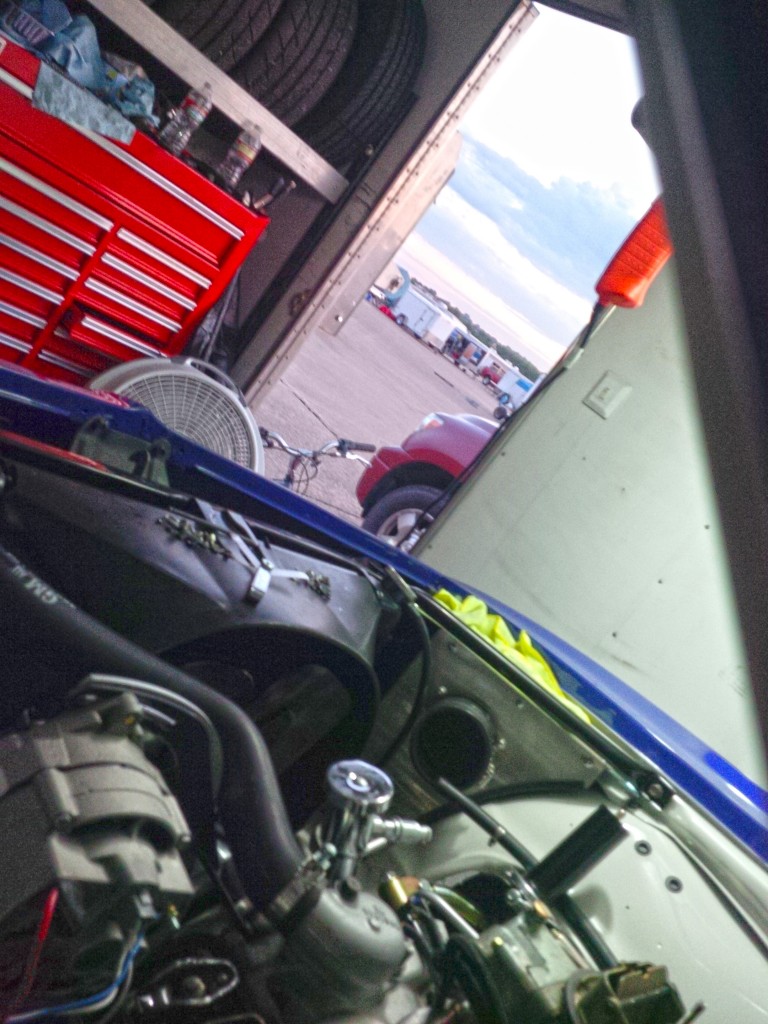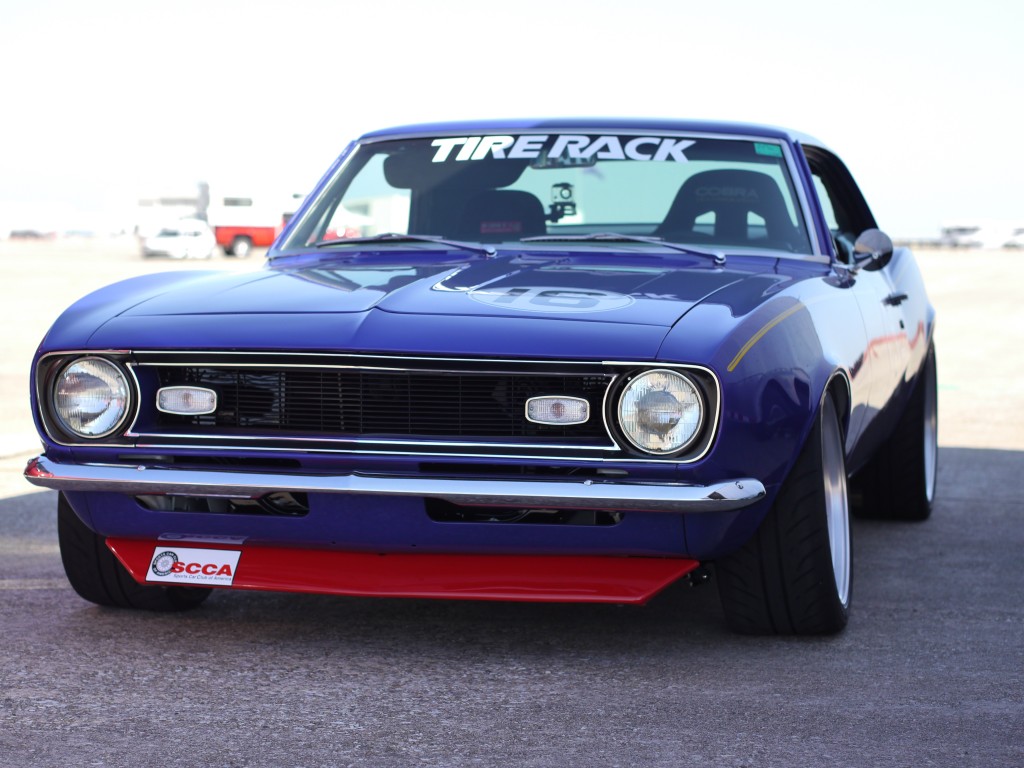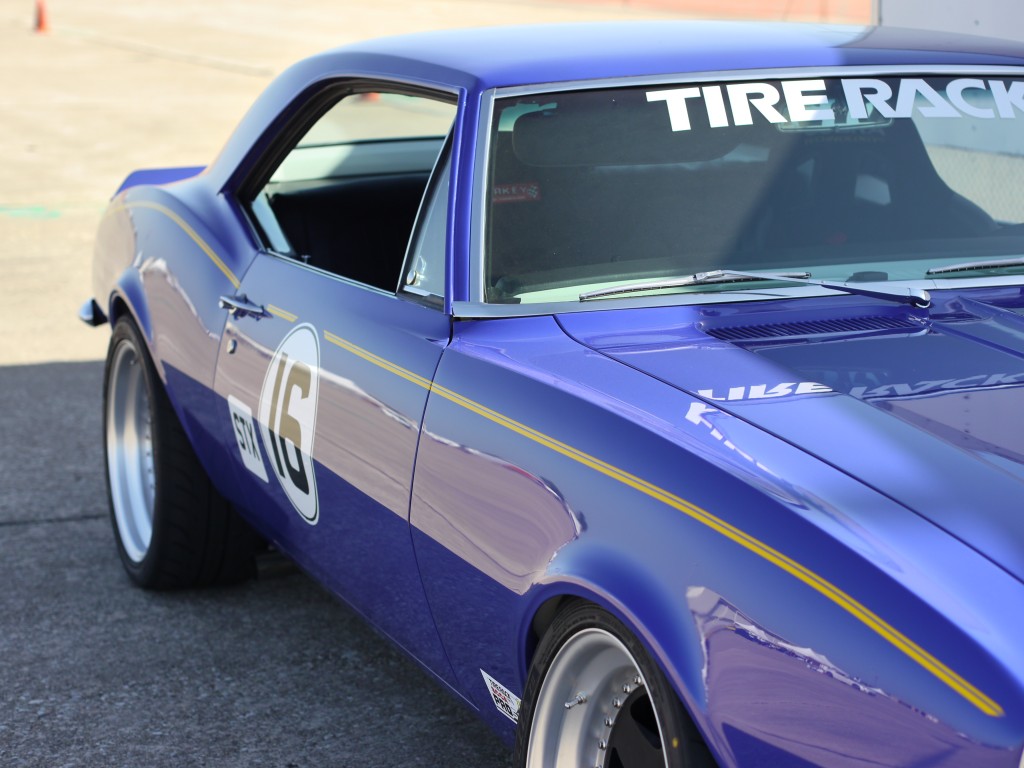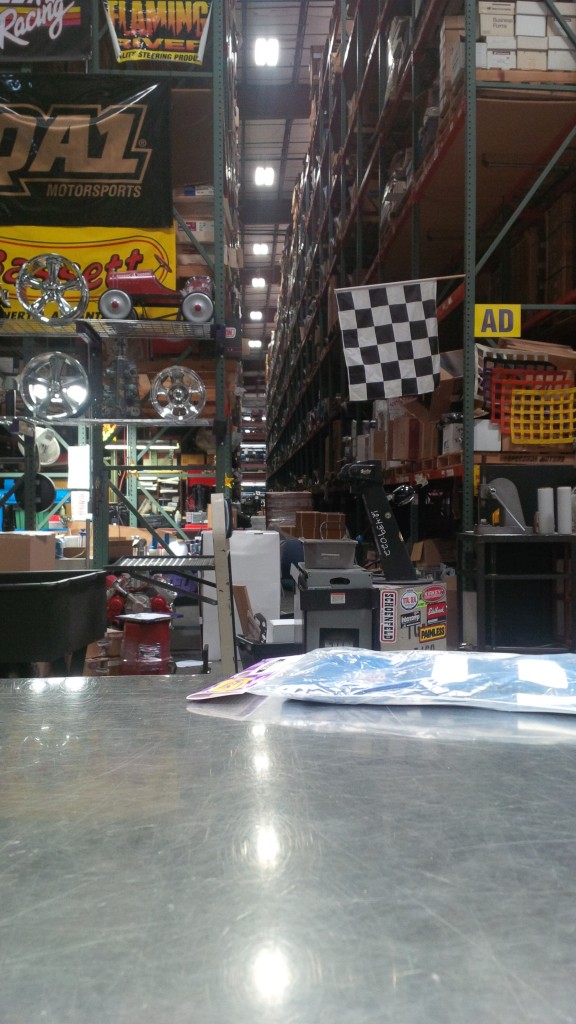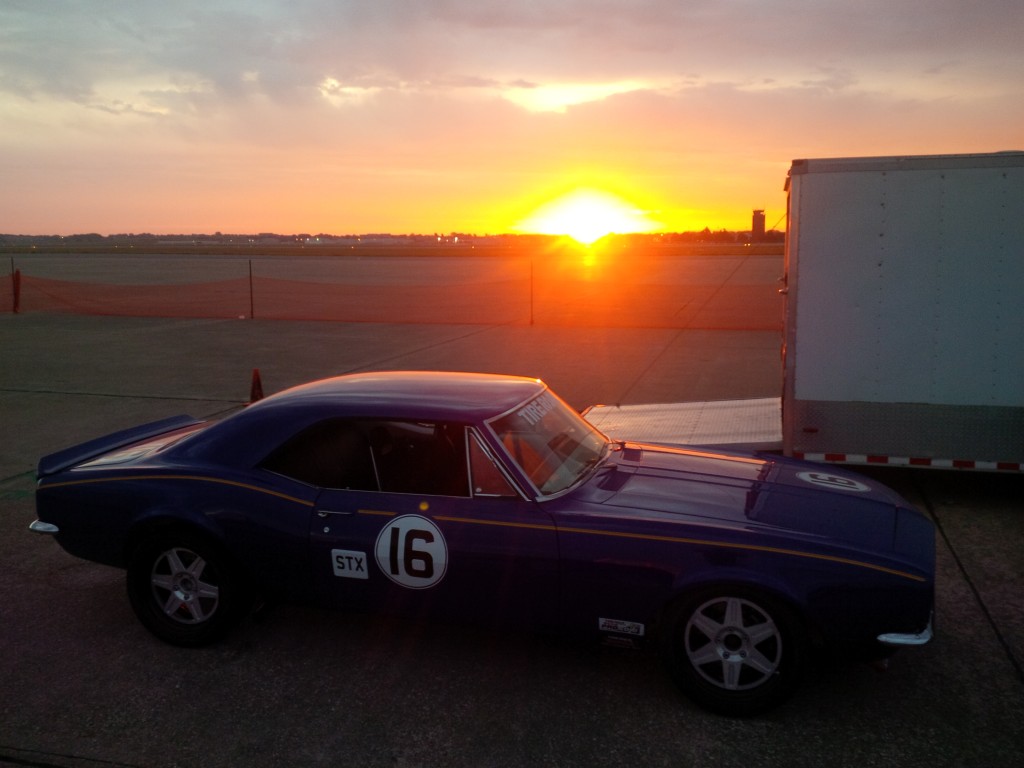2013 National Championships
Well, that was about what I expected…
After a better-than-expected finish at the ProSolo Finale the weekend before, had high hopes headed into the Solo National Championships.
At the Pro the car finished 5th, ahead of some car/driver combinations I had no business being ahead of. Some of it was a course that favored the car, some of it was in the problems those car/driver combos had. The Camaro at this point is rather tricky to drive – I don’t yet have a good feel for the brakes, am still learning the requisite throttle control, and overall, the car is much less forgiving than it could be. With 6 tries at each course in the Pro, it gives me the chance to learn the correct braking and throttle application points by experience, vs. going by feel or judgment. Worked there, but you don’t really get those chances in the Solo…
The Pro ended on a Sunday, and STX didn’t run until Thursday/Friday. This gave three days to further test and tune the car, and I had time slots Monday, Tuesday, and Wednesday.
Monday’s slot was used to test a shock change, with everything else from the Pro totally left alone. Up to that point, the car had always felt very “dead” in slaloms. At the car’s very first event, I’d turned the shocks from an unknown initial setting (which turned out to be full stiff) to full soft in all 4 adjustments (rear shock description). In general in a powerful RWD car I like the rear shocks set a little softer than you might want for ultimate pure-handling performance, as it makes the car a little more forgiving of incorrect throttle or brake inputs. And the car was so deadly loose early on, full soft made sense.
As the grip in Lincoln was very high and my comfort level with the car was rising, the first real shock change I did, was to take rear rebound from full soft, up to about 25% stiff in its adjustment range. The car responded very well in the slalom on the test ‘n tune course, really starting to come alive in those transitions. “More” might have been better but that was a start, and I didn’t want to overshoot and make the thing a nightmare.
Monday I was approached by the GRM crew, they were interested in doing a shoot with the car. Even at 6:30pm it was still a little bright out to do engine bay shots, thankfully Tom McDaniel was there to lend a hand, and some big sign thing, to help them out.
Tuesday test ‘n tune covered the switch from the Hankook RS3 tires to Dunlop Direzza Z2. As we were running in the first group in the morning, which would be relatively cool, and I had no codriver, I felt this was a more appropriate choice given the likely difficulty I’d have in getting (and maintaining) enough heat in the Hankooks.
The Dunlops were on the new CCW “Classic-5” wheels in 18×9. These wheels have a very nice vintage look, and since they were made with quite a bit less backspace, they can be run without spacers, while providing a much more aggressive “deep dish” sort of look. From before:
Unfortunately the car had a bit of a rubbing problem in the front with the wheels at this backspace. A little bit of rubbing is ok, but I was worried not just about damage, but about what sort of funky understeer moments this extra “brake” on the outside front tire might cause. Cut this session short with 2 runs, and had a pair of the Dunlops mounted on the higher-backspace Jongbloed wheels.
Wednesday’s test session had the new front wheel setup, and I also changed out to my lightweight “Nationals” battery. In the picture below, it’s the one on the left-
It’s an XS Power C680, which is the same form factor as the Odyssey PC680. It’s shown next to the Odyssey PC1200 I’d been running. The lithium battery is crazy light – under 4 pounds. When you pick it up, you’d swear it had to be an empty battery case. This switch saves 35 pounds, and since the car burns fuel so fast, it was probably under 2950 competition weight for most runs.
Speaking of fuel, this thing drinks it up! The tank was nearly empty on the trip out, and I decided to do most runs with the tank full (note the signs of fuel having sloshed out the back in the battery picture above) – and on this trip, the car got over 27 gallons put in…but I think the stock tank is only 18 gallons. Major thirst!
Here is video of my second test ‘n tune run Wednesday:
Was pretty happy with the way the car was working here – again, I’d had several chances to learn the braking points, and how the car was going to behave in each section. This was a 31.1, which wasn’t far off the times I was hearing from the other STX and STR guys – mostly 30.6-30.8.
One other thing I got going Wednesday were some more features of the car’s Motec dash unit. It features a full data logger with 3-axis accelerometers, and I’d also purchased the GPS option. Hadn’t got the time to get it working previously, but thanks to good support from Jeff Feit at Optimum Motorsports was able to figure the last bit out, GPS and data logging all set for the big race.
Thursday was a nice warm morning, thankfully the price we paid in suffering the heat, meant this was a Nationals where rain wasn’t a totally devastating factor for some people (my ninth trip, first time that’s been the case).
First run out felt pretty good on Sam Strano’s east course. Car was running strong..missed some spots and broke way too early in others (including the showcase turn) but a decent first run. Unfortunately when I came in, there was no time!
Turns out that happened to about 8-9 of us. No big deal, I’ll take another free shot at things…
Second run started out better, but not wanting to brake too early or too lightly, I spun the car under braking after the slalom after the showcase turn. Didn’t think my inputs were that worthy of a spin, but there was the rear rebound change, plus the bias had been shifted with the move to equal-diameter rear tires. Bummer, so my first run with a time, is a throw-away.
My “real” second run was an improvement, but still about 2 seconds off where the leaders were running. I was being very careful on the brakes, using them waaaaay too early into the showcase turn, a mistake I saw lots of people making.
Here’s the video – note the head-shake in the middle of the showcase turn (around the :20 mark)
Another thing to note in the video, is what sounds like the rev limiter as the car heads out in first gear. There are a couple other places where it does the same thing in second gear.
While driving, I thought it was the rev limiter, and was surprised how fast the course was; even with the shorter tires and lower rev limit, the car was good for mid 60’s mph in second. Gary Thomason was watching and said it sounded like things were “breaking up” at high RPM, like maybe the ignition was failing, or the valved weren’t adjusted properly. They had been adjusted recently, hmmm. It wasn’t doing that on my first run, but definitely was now, and it was throwing me off a bit, as it was a distracting sound. The one or two times I had a chance to look down as it occurred, the tach was around 6k, not near 7k where the limiter sits (6900).
Third run felt about the same as the second, and was a little bit slower. Something definitely wrong at high RPM.
Much later that day after the engine had cooled, went to adjust valves. The first few were ok, then I got to the #2 intake valve, and found it very very loose. So I tightened it, and it still seemed loose. Then I noticed bits of metal sitting there next to the valvespring. Uh oh. The rocker looked ok from the top…
But not from the bottom. Those bits of metal must have worked their way between the rocker arm tip and valvestem top at some point, causing this damage to the rocker. Fortunately the valve looked ok. The pushrod, on the other hand-
Not so good. Somehow the tip completely went to pieces. Not sure exactly how it happened, but this was certainly contributing to the high-rpm stutter the car had been displaying.
Fortunately Speedway saved my butt yet again, with a box of fresh pushrods. I don’t know in how many towns you can find a place with stock SBC pushrods in stock at 5:30pm on a Thursday night, but I am thankful Lincoln is one of them.
Got back to the site and replaced all 16 pushrods just to be safe, inspecting the old ones, and all the rockers in the process. Fortunately everything else looked fine, no apparent collateral damage.
Was a little tired by the time this work was completed but the car started up and sounded fine in the trailer at 9pm.
…
Friday started earlier, so it was cooler, still dry. I was in high 20-somthing-th place, but that didn’t feel too bad. The car hadn’t been running right the day before, and 2 seconds on a 75+ second course isn’t *that* bad for the car’s first trip out…I could try to close the gap a bit today, maybe move up into the trophies?
Alas, it was not to be. Friday we ran Elliot Spiedell’s West course, which was much more a classical handling/speed-maintenance course (though to be fair there were a few little acceleration spots). Here is my first run, which ended up being the run I’d stand on:
My head wasn’t really in it, and to make matters worse, the car was apparently smoking badly on course. Visual inspection showed the passenger valve cover leaking at the back, oil making its way onto the header. This made sense, as I’d had them off the night before, and maybe didn’t tighten that one enough, or perhaps the gasket didn’t seal.
That was an unwanted distraction from what should have been spent figuring out where and how to go faster. Second run was better in spots, but mistakes in others, working out to almost exactly the same time, plus a cone. Apparently the car was smoking even more now.
Found an allen wrench and tried the only thing I really could with everything super hot – tightening the valve cover.
Unfortunately that did what tightening in these circumstances normally does – it made it worse. I don’t have any good pics yet but apparently on its third run, the car was a James Bond smoke-screen in full effect.
Realizing I was pretty much out of it at this point I pushed the car a little harder on the third run – taking those chances netted two cones – but the raw time was still over 2 seconds off the leader, on a 56-58 second course…which felt much worse than the 2 seconds on a high 70 second course. Partly because the % gap from the lead, but also because the car seemed to be running fine. A bummer result, to never really feel “in the hunt” for a trophy, much less the win. Ended up 29th of 59.
…
What is plaguing the valvetrain? Besides the engine troubles, why was the car so slow? What does the data say? Where do we go from here?
Wasn’t this update long enough? We’ll get to that next time… 🙂
2013 ProSolo Finale
The 2013 ProSolo Finale is in the books, and by most accounts it was a success!
In SCCA autocross there are two series of events run in parallel – “regular” Solo competition consists of 3 runs taken on a given course, where there is usually a sharp turn before the clock starts, to eliminate a launch advantage. Big events last 2 days, with the course run one direction on day 1, and the other direction on day 2, with the lowest sum time winning. For the Solo National Championships, instead of running the same course different directions, you run two separate courses.
“ProSolo” consists of two courses set up in mirror-image, with competitors lined up side-by-side. Between them is a drag tree, which brings the driver’s reaction time, ability to stage the car, and their skill in launching from a dead stop, into play. In ProSolo the drivers get to run each course six times for a total of 12 runs – each course twice Saturday morning, Saturday afternoon, then Sunday morning.
ProSolo is a lot of fun, and the back-to-back runs can be pretty intense.
The week of National Championships in Lincoln Nebraska starts with the ProSolo Finale – the last event in the ProSolo series – there are winners for that event by itself, but since ProSolo has points, it also determines who is the year-end class champion. After the Finale, the regular Solo National Championships are run – half of the people run on Tuesday/Wednesday, the other half Thursday/Friday – there are over 1200 entrants so it takes 4 days!
For me this year, the ProSolo Finale was mainly a big test and tune event to make sure the car is ready, and the driver is warmed up for the Solo National Championships I’ll be running Thursday/Friday.
Having successfully completed the Pre-Nats Thrash of the previous post, got the car out to Lincoln with a long but smooth two-day trip. Unloaded the car and took these photos – the wheels are CCW Classic-5’s – 18×9, with a lot less backspace than the Jongbloed’s I’d been running. The CCWs are a bit heavier but have a nice vintage look.
I’d signed up to run the Test ‘n Tune the Friday before the ProSolo just to make sure everything was ok and to get warmed up. It was blisteringly hot that day (over 100) which made doing anything a chore. At the test ‘n tune, on the first run, the car wasn’t running right. I suspected it might be some intake tricks I’d tried, so I drove back to the paddock and undid the tricks, trying not to burn myself. Back at the test ‘n tune waiting to do my second run, the car stumbled a bit, then shut off!
That seemed strange to me, and the way it died in a not-so-sudden way, more of a stumbling death, made me think it might be fuel. In building the car I goofed and didn’t connect the fuel gauge sending wire, so I have no gas gauge – it’d been totally full for the San Diego Tour earlier in the year, but I hadn’t added any since. The Camaro holds 18 gallons, which means that with Sunday morning runs at El Toro, the Farmington ProSolo, and a few other miles of miscellaneous putting around and idling, the car burned 18 gallons!
Fortunately the fix here was easy – add gas! 5 gallons in and it was good to go for my second test ‘n tune run.
On this run, something else bad was happening – there was a bad cycling rubbing sound coming from the left rear. I’d been interested in how things looked back there, so I had the camera watching the left rear from the outside. Sure enough, upon review, the axle was moving all over the place! Big lateral deflection, combined with axle tramp, made the rear axle look totally out of control. Somehow I’d been able to get away with this setup before…maybe it was the grip from these new-gen tires on concrete, maybe it was fatigue in the U-bolts holding the big sandwich together, not sure…but in any case, it was very not happy.
To combat this, I skipped the last two tuning runs, and headed back to the pits to get to work on the car. Wanted to remove the big spacer blocks from the equation. Since the axle perches expect a multi-leaf spring pack, and I’m running a single composite leaf, would need *some* spacer block. Fortunately, the central warehouse for Speedway Motors is here in Lincoln Nebraska, only a couple miles from the event site
From their huuuuuge warehouse, was able to get 1/4″ and 1/2″ spring spacer blocks, and the 1/2″ turned out to be perfect – it snugged the plate for the driver-side watts link connection right up to the welded-on spring perch, reducing the leverage these parts had on each other significantly.
Saturday morning for the first set of runs I was rather apprehensive. It was very hot out (already in the 90’s), and the car had two failed test ‘n tune runs the previous day, and no testing on the new setup. To my delight, things went well. The car completed its Saturday morning runs without issue – though I did happen to spin on my last run. Times were quite a ways off the pace (about 1 second per side) but I was putting a lot of attention into the car – wanting to be sure it was running properly and healthy, and that nothing was rubbing or coming apart – instead of focusing on driving and hitting my marks.
Saturday afternoon was a bit of an improvement, even though it was extremely hot (100+) when we ran. For this session I moved the camera under the fuel tank to watch what the axle was doing at the left rear:
Interesting to watch – lots happening under there in an autocross run. Water temp was about 215 when I finished but all systems (cooling, power steering, charging, etc.) seemed to be taking it fine.
I wanted to adjust the valves Saturday evening before it got dark out, but doing so requires a cold engine – even after sitting for 2.5 hours after my Saturday afternoon runs, most of the engine was too hot to touch, so it was put off to Sunday morning.
Sunday arrived at the site a bit early to do the valve adjustment. Turns out the new rocker arms and balls wore-in quite a bit, and gotten far out of adjustment. That was costing the car some power and could impact reliability, so I was very thorough in getting everything adjusted properly.
Sunday morning’s runs were better – it was cooler, the cornering grip levels had come up, and I was feeling more confident in the car holding together, allowing me to focus on driving. Ended up dropping enough time to move into 5th place – with 15 drivers, good enough for the last trophy spot! Pretty satisfying to get a trophy at only the car’s 4th event ever, against some very skilled drivers in “proper” cars.
Overshadowing the excitement of that result, is how still very far back I was from class winner Bryan Heitkotter’s times. Bryan couldn’t get his Nissan 300ZX prepared in time for the Championships this year, with a silly excuse, having been called by Nissan to run a GT3 GTR at Infineon, over the last weekend he had to prepare the car. So instead he ran Charlie Davis’s E36 BMW, the car he won Nationals in last year, a well prepared car he’s very familiar with, and fast in. Bryan is running a different class for the Solo Nationals so he won’t be a worry there, though the class won’t have the same weight without him in it – for our measly entry fees, we get to run heads up against professional race car drivers! Pretty fun aspect of SCCA autocross.
Between now and Thursday, need to figure out how I can go .6 seconds faster per 50 seconds of course – which was about the gap from me to the second-fastest STX car, since Bryan is out. Some of that may come from driving, some from further tuning. Will be a busy next few days for sure!
Here is a high resolution video of my best two runs from the ProSolo.

